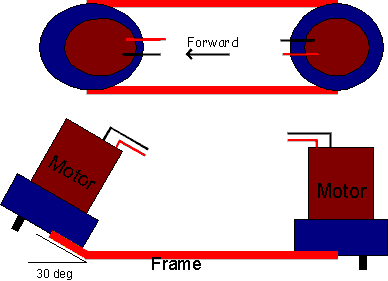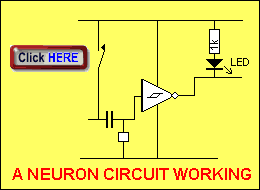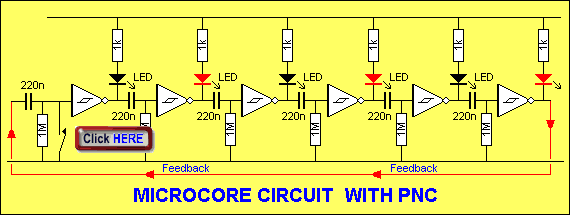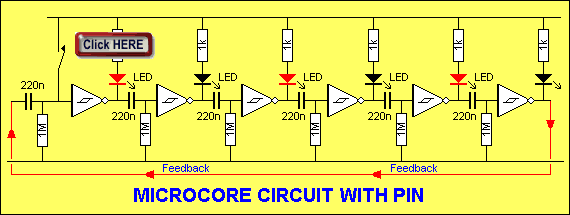WALKING
ROBOT
Page 8
How to make a Robot Walk
This information has been adapted
from an excellent site by A
Miller.
P1
P2
P3
P4
P5
P6
P7
P9
P10
![]()
Introduction
This section describes how to make a walking robot. The simplest robots are
called BEAM ROBOTS. And the simplest walkers are called BEAM WALKERS. They
consist of just enough circuitry and mechanics to carry out the intended function, and in this case it
is the operation of walking.
The simplest circuit to get a robot to carry out the walking function has been
designed and patented by one of the earliest developers of Robots, Mark W.
Tilden. He gave the name MicroCore to the type of circuit that drives these
basic designs.
The concept of the MicroCore is pretty clever. Using just a handful of
components, you can build the control circuitry for a walking robot that
senses its environment and adjusts its gait accordingly. The clever part is the circuit is so
simple!
A MicroCore consists of a capacitor, a gate, and
a resistor. This is called a 'neuron.' Each neuron has an input and an
output. The components are connected so that the capacitor and resistor form
a delay circuit. If we make the input HIGH, the output take a short time to
react. Mouse-over the animation below to see how the Neuron circuit
works.
The gate is actually an inverter and it also has the ability to
strengthen the pulse. If we connect the output of one neuron to the input of
another and take the output of the second to the input of the first we have
a complete loop and we have created a BiCore.
MicroCore
A circuit can consist of as many gates (inverters) as you want, hooked-up nose
to tail. Every 'neuron' of a MicroCore consists of a capacitor, a gate, and
a resistor. A circuit containing a number of 'neurons' will produce amazing
things. This is what this discussion is all about.
If you have a BiCore controlling two wheels, and want the robot
to turn right, you have to make the motor on the left run for longer -
simply change the resistance for that neuron. If you incorporate 2 photodiodes
into the MicroCore, you can make a robot always zigzag its way towards
light! This is really impressive and demonstrates how simple
"complex behaviour" really is.
In this discussion we are going to explain the operation of the . . .
The
MicroCore circuit can be likened to a
nervous circuit in that it gives life and realism
to a robotic shape. The MicroCore circuit is a basic circuit used in the
majority of BEAM Biomorphic walkers.
To get an idea of the basics of this topic, the following paper was prepared by
Mark Tilden:
|
Biomorphic Robotics and Mark W. Tilden, Nervous Net (Nv) technology is a non-linear analog control system that solves real time control problems normally quite difficult to handle with digital methods. Nervous nets are to Neural nets the same way peripheral spinal systems are to the brain. This work has concentrated on the development of Nv based robot mechanisms with electronic approximations of biologic autonomic and somatic systems. It has been demonstrated that these systems, when fed back onto themselves rather than through a computer-based pattern generator, can successfully mimic many of the attributes normally attributed to lower biological organisms. Using Nv nets, highly successful legged robot mechanisms have been demonstrated which can negotiate terrains of inordinate difficulty for wheeled or tracked machines. That non-linear systems can provide this degree of control is not so surprising as the part counts for successful Nv designs. A fully adept insect-walker, for example, can be fully controlled and operated with as little as 12 standard transistor elements. Since the start of research in the winter of 1994, development of this technology has advanced to solving currently difficult sensory and cognitive problems. It is hoped in the coming years Nv systems may do for robot vision (amongst other disciplines) what has been done for autonomous robot vehicles, namely the reduction of currently complex systems down to an inexpensive but robust minimum. Further efforts are also being made to apply this control strategy to the expanding nano-technology field. At the nanometer scale Nv's may prove more feasible than nano-computers for control of self-assembling micro structures. For now, however, Nv research concentrates on problems of scale invariance, proving by example (or exhaustion) this control system can work at all scales, types, and styles of robotic application. The Nv control method could be adapted to most types of machine control, but it has been applied to autonomous robots because of the difficulty conventional control systems have solving the seemingly simple task of negotiating undefined complex environments. The 80 or so "biomorphic" robots (from the terms BIOlogy and MORPHology, and the Latin for "living" and "form") built so far are not "workers" in the traditional sense, but "survivors," in that they fight to solve the immediate problems of existence rather than procedural condition (i.e. they do not follow the rules of an internal program that mimics the external world, but the world itself). Nv control architectures focus on adaptive survival rather than the performance of specific tasks. Once survivability is under control, goals can be superimposed and the machine used as a platform to carry sensors and conventional electronic intelligence. It is believed that these machines, although now in an early stage of development, can within a few years be brought to the point that they can serve as inexpensive, robust, and versatile carriers for a variety of instruments. A vast number of applications would then be possible, including the location and possible clearing of land mines from civilian areas, security, maintenance, medical and prosthetic applications (a cost-effective "walking wheelchair" for example), and even cars with on-board "survival" instincts to save themselves and their passengers, from damaging accidents. Though the Nv based legged devices built so far cannot go everywhere, they can certainly go places not currently accessible to wheeled or tracked vehicles of similar scale. It seems that for handling undefined environments, biomorphic designs are a very efficient and cost-effective approach. Initially it was thought these devices avoided the problems of an internal world representation by using a reactive or behaviour-based technique. Recent work has shown however that Nv biomorphs instead take a chaotic map of their surroundings onto their process control hierarchy (that is, they dynamically and efficiently adapt to the fractal complexity of their surroundings). This is due to the analog-electronic nature of the devices, the adaptive hardware of their structure, and the topological orientation of their interconnections. The defining characteristic of this adaptation is continuously updated by the immediate fractal complexity of the environment. These devices are "soft" designs, in that the environmental dimension must be absorbed, modified, and acted on for the devices to make successful headway through a complex world. These devices do not use "feedback" in the standard sense, but rather "implex", as the driving forces are augmented by perceived load rather than by a separate regulating path. The result is highly compliant, animal-like machine motions that "negotiate" rather than "bully" their way through environments, resulting in minimal damage to both world and robot. We talk about these devices in the general sense because the precepts of their existence and subsequent design are based upon environmental macros, such as fluidity, turgidity, gravity, scale, materials strength, and many other factors. The power of biomorphic designs is that this information is used as the defining principles to shape appropriate survivor(s) for a particular environment. The machines that emerge are vastly different from any conventional robotic forms. We suspect, at least from the experimental evidence, that this technique embodies a new type of non-linear control paradigm, and at least an entirely new engineering discipline for the matching of competent machines to complex environments. Here, once the problems of existence are ratified, the devices can do unsupervised, long term work without human intervention (some devices have been in continuous operation for over 5 years). The potential for this control paradigm is vast, but it is far from linear, and requires integrated design attempts to pull a competent ability from the Nv nets. To this end, the use of this technology to "evolve" machines from a lesser to a higher operational state has resulted in not only a wide spectrum of devices, but even completely different "species" of creatures, all evolved from a primal "genotype;" the single "cell" creature known as Turbot 1.0. A further advantage is the speed at which this evolution has occurred, indicating that real-world Lamarckian evolution may match the success of many computer models yet seen. The diversity of this technique offers potential solutions to two main research fields, macro and micro robotics, and experimental work has been done to produce adept prototypes for both. The conclusions are that there may be some universal chaos-bounded concepts that bind survivor oriented designs, allowing for the creation and optimization of devices that can do work in any environment, under many situations, using chemically inert, and thereby relatively safe, control techniques (the idea of seeding a wheat field with pest-fighting silicon biomorphs to produce high yield, insecticide-free foodstuffs is an attractive example). Considering that biomorphs may last long enough to replace most forms of long-term damaging chemicals (i.e. pesticides, bleaches, medicines) the potential for the field really opens up. Deployed artificial chemicals perform a task in their immediate area of concentration, and then disperse into the environment where, after a time, they cannot be absorbed adequately. Biomorph machines, made from biodegradable silicon and trace elements, can be made gregarious so they do not of their own volition disperse, and can be absolutely controlled by conventional methods. Whether at micro or macro scales, these designs are not just capable, but competent. Furthermore, as they are self "programming" and non-reproductive, their behaviour is both contained and predictable. Nv biomorphs are something new with a demonstrable potential. Future work will concentrate on how this technology could fill in the cracks between science fiction and reality by finding out what is feasible now, and how to logically proceed to marketable, capable machines. In the coming years, it is hoped to be possible to demonstrate real machines to assess feasibility for macro and nano robotic applications. Expansions of the fields of robo-biology, robo-morphology, and artificial ecologies will be studied and published, along with extensions of this field from self-repairing processors, new computational paradigms, and even nano-robotic surgeons-in-a-capsule. Biomorphics is new, but it is slowly gaining the maturity and acceptance necessary to become a valid work tool. |
The basic circuit for a MicroCore consists of a capacitor, a gate, and a resistor. The arrangement of the components is shown in the circuit below. This is called a NEURON.
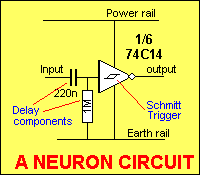
Mouseover the NEURON circuit below to see how it works. The secret to the operation is this:
The capacitor charges and the circuit changes state a short time later. The capacitor and resistor form an arrangement called a DELAY CIRCUIT. The LED has been added to the output of the gate so we can see how and when the circuit operates.
We are interested in the operation of the output AFTER the input has
changed. The circuit is just like a spinal cord without anything attached. It
is called an Nv circuit. You can't drive motors yet but until you
understand the basic states of the MicroCore circuit, the operation of motors will make even less sense than the LEDs.
Two Neuron circuits will work when connected head-to-tail and with the
output of the second connected to the input of the first:
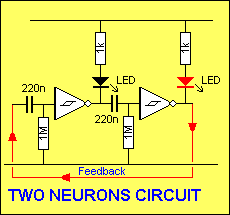
The operation of the circuit is shown in this animation:
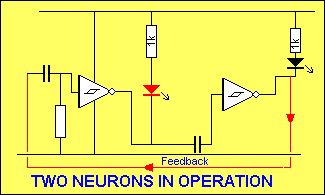
You will notice the capacitor charges via the 1M resistor as the input of
the gate is a very high impedance. When the output of a gate goes low, the
capacitor is discharged via a diode on the input line of the gate. This diode
is a Schottky diode and is designed to prevent the input of the gate going
below 0v. The change from one state to the other is almost instantaneous and
only one LED is illuminated at a time. We have slowed down the animation to
show the gates in action and the two LEDs appear to be off for an instant. This
does not actually occur.
If we extend this circuit to the 6 inverters of a hex Schmitt Trigger IC, and
take the output of the last Nv circuit to the input of the first, we get
a circulating pattern. The circuit will always start-up and each alternate LED
will be illuminated.
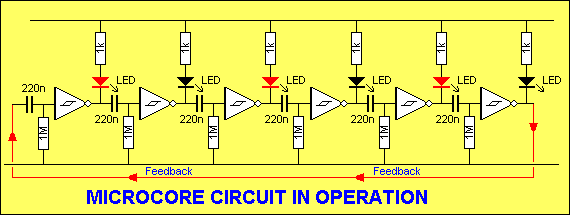
When the circuit is connected to a Robot, the following effect will be produced:
![]()
This is known as the Saturated State. This means all Nv's are firing at Max rate. There is a Maximum of 3 Processes.
A process is defined as one LED/Nv ON at any one time. Note: there are never two
illuminated LEDs side-by-side at the same time. This is the Fermei
exclusion feature of the MicroCore and an attribute shared by biological Nv nets.
Saturation is the natural Power-on state. It is the crazy-go-nuts state for a Nv
Net - like a bug that has had too much
coffee. Saturation will occur when the MicroCore encounters a disruption
in main power or when too much data is received from sensors or Nu/Nv nets.
Fortunately it's easy to get a more stable useful state.
Adding a Process Neutralization Circuit (PNC). Wire up a switch to short out
the input bias resistor like this.....
Closing the switch destroys any re-circulating pulses. Hold it long enough and all processes are destroyed. This is called the Null State, Off State. This is a Nv net at rest.
![]()
Two Process State
. By holding the switch closed for approx 2 seconds you should be able to achieve this....![]()
If all values are even, and no
glitches or noise is received from the motor, the processes should fall 180 degrees out of phase with each
other. This is seen when they appear to be running side by side with each
other. Two processes are like Parkinson's disease. The Nv's are
trying to act against each other and if they fall into this mode, you have "lock
up." This
state can be useful in some cases but in the case of a simple walker it's
not much use.
![]()
Adding a Process Initialise Circuit (PIN). By wiring up another switch from an input to Vcc (+ve) you can introduce processes to the MicroCore. By using the PNC and PIN switches you should be able to cycle through all the MicroCore's usable states.
Now build the circuit and play with it. In this discussion we are going to concentrate on a
two motor four leg walker which although it is not the most flexible design, it is the easiest to build and has proven its reliability and capability in 35 existing machines.THE MOTORS
This is probably the biggest consideration in a MicroCore Walker. The level of success you have with your walker is directly related to the type of motor used. The MicroCore itself gets an implicit feedback from the motors, this is what gives it the adaptability.
What to look for in a Motor....
EFFICIENCY: This is REALLY important both from a power consumption standpoint (more-efficient motors require a smaller battery or main-storage electrolytic). High efficiency motors give you a better chance of success. You should look for a motor with at least a 35% efficiency rating, good cassette motors and pager motors typically fall into this range, Mabuchi hobby motors are way off (typically10%). Much higher efficiencies are possible (up to 88%) but this is usually found in expensive medical grade motors like "Escap" and "MicroMo." Keep your eyes open when perusing the surplus catalogues, these sometimes go on sale for as little as $5.
SIZE: For the most part, smaller is better but it's not as important as efficiency. As well, you may want to consider your own skill level. In the beginning, don't try to work with things that are really small. Make sure you have extra motors. They come in handy.
THE GEARS
You canít build a walker without them. A motor alone doesn't put out enough torque and usually runs too fast.
What to look for in a gearbox...
Efficiency/Size/Numbers: For all the same reasons as above.
Compliance: This is really critical. You should be able to grasp the output shaft with a pair of pliers and turn it to have the gears spin the motor. If you can't make the motor spin, then you have a gear train that is too inefficient (most likely) or too high a ratio. Worm drives are also OUT, they only go one way (motor to gear and not gear to motor) and they tend to choke under high loads.
Output RPM: The ideal is about 30 RPM @ 5V. Higher RPM means you probably won't have enough torque (and if you do, the robot will jump around so fast it's hard to figure out what it's doing). A lower RPM means the machine may be moving too slow to be of use. A high ratio may mean the legs will bend under the torque.
INTERFACING MOTOR AND GEARS
I strongly suggest you find a factory motor/gearbox combination. If you have to build your own then bear a couple of things in mind......
Direct gear contact: belt drives, friction drives, flexible shafts etc all have big problems as far as efficiency and compliance are concerned.
Keep everything clean: Glue, solder flux and metal fillings are deadly enemies to gearboxes.
MATERIALS
Solder is our friend, only use materials that can be easily soldered. This will make it easy to build a frame. Welding wire or filler rod is the best. Copper clad carbon steel rod 1/6" to 3/32"diameter is cheap and available at any welding supply place. Any nice shinny option is High Nickel rod used for TIG welding cast iron but it's MUCH more expensive. Brass tube and wire found at most hobby shops is good too. I suggest a solder with an organic/water soluble flux, "Hydro X" by Multicore is my favourite.
BASIC FRAME LAYOUT
The diagram below shows the basic layout. You need to keep the motors and output shafts lined
up front to back and the front motor should be tilted at 30 degrees. This
means the front motor will supply lift and push but we'll discuss that
more later. You should mount the motors far enough apart to fit all your
electronics including batteries (usually about 4").
